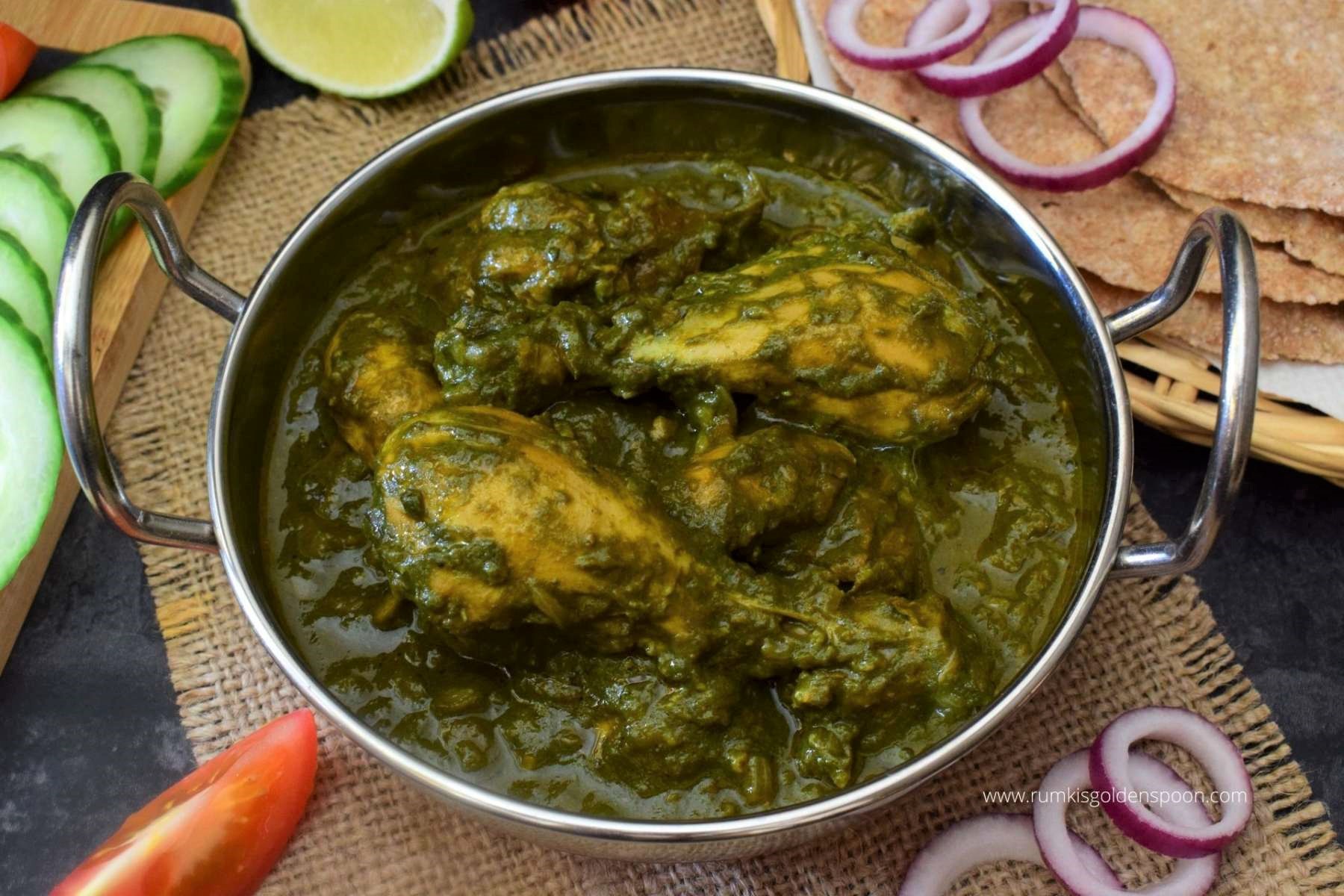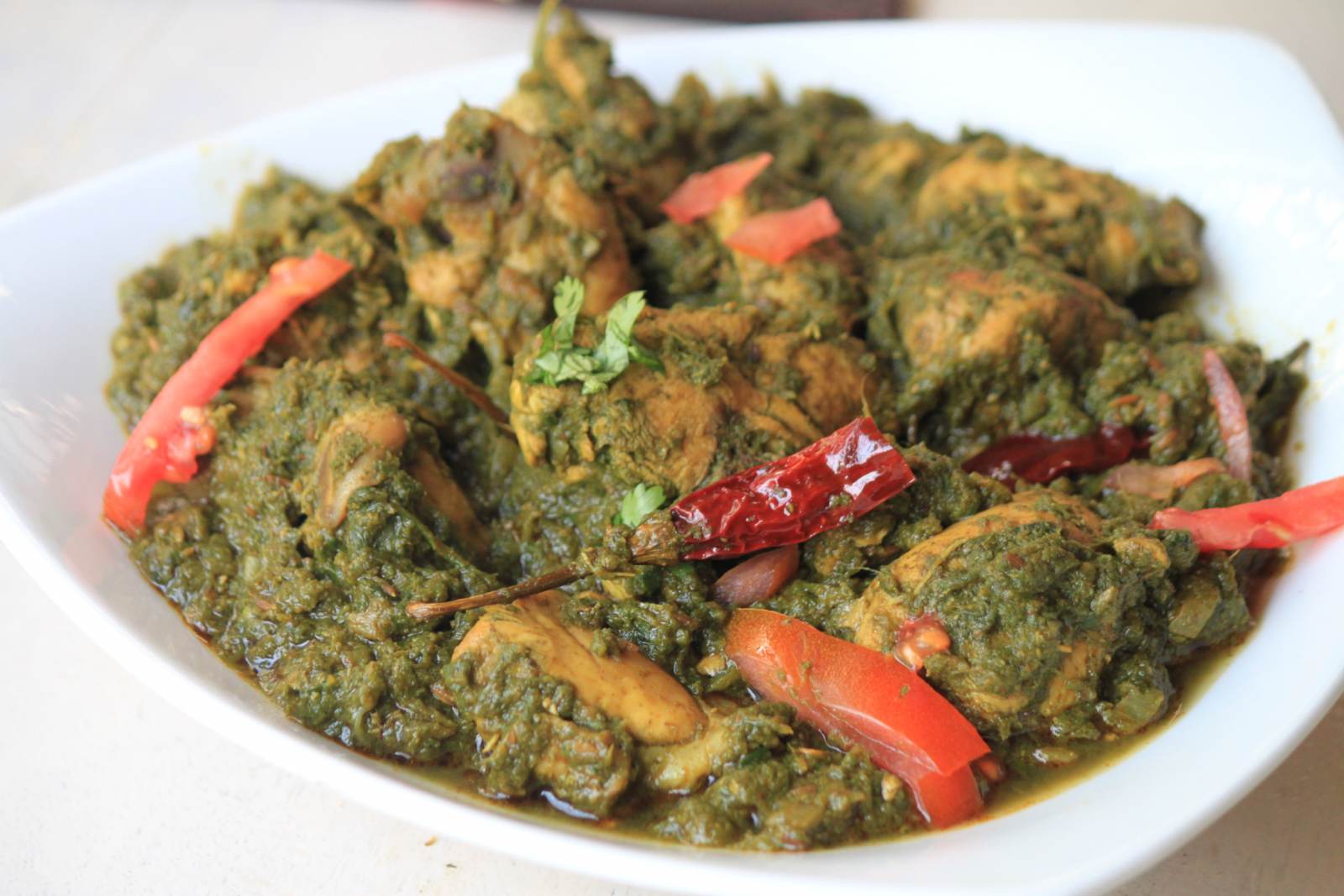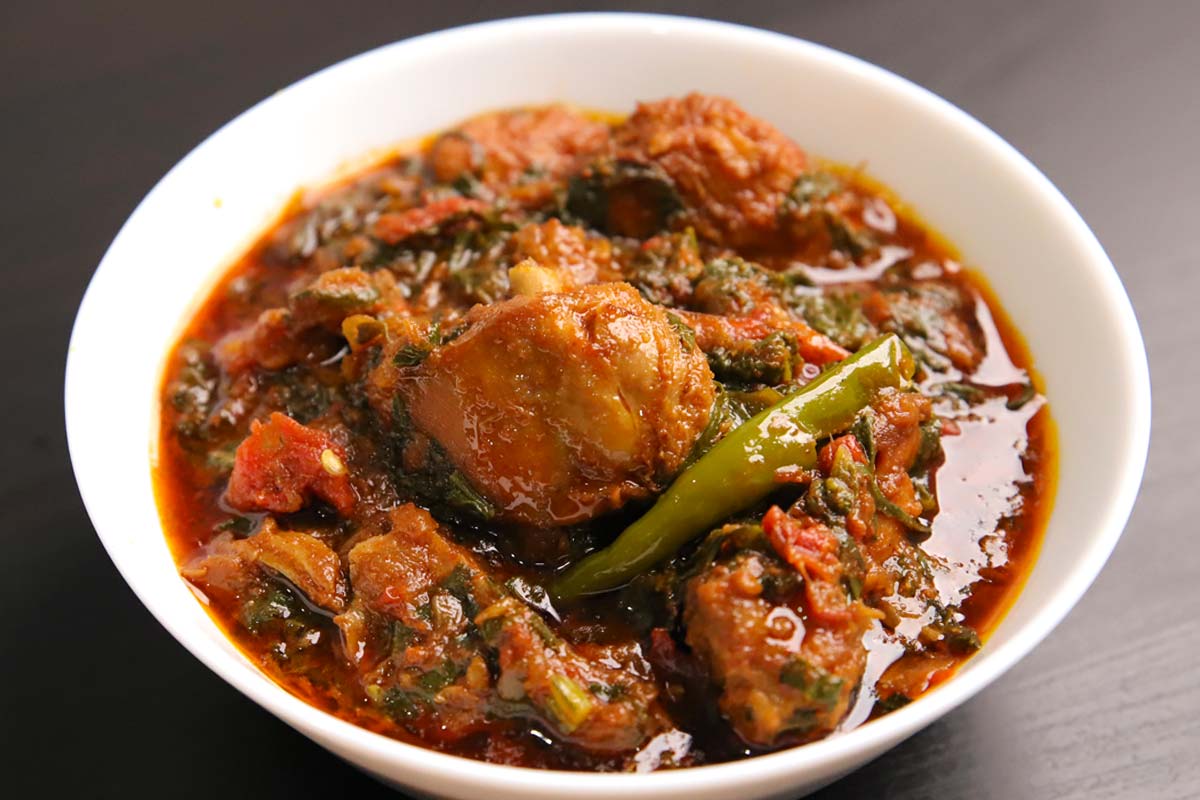Embark on a culinary journey with Recipe For Palak Chicken, a delectable dish that tantalizes taste buds and nourishes the body. This vibrant creation, steeped in tradition and brimming with flavor, invites you to experience the harmonious fusion of succulent chicken and vibrant spinach, complemented by a symphony of aromatic spices. Prepare to savor every bite as we delve into the secrets of this beloved delicacy.
From the gathering of fresh ingredients to the mastery of cooking techniques, Recipe For Palak Chicken unveils the culinary secrets that transform ordinary ingredients into an extraordinary masterpiece. Join us as we explore the intricacies of this culinary gem, uncovering its health benefits, cultural significance, and endless possibilities for presentation and serving.
Recipe Ingredients and Variations

The ingredients for Palak Chicken form a flavorful blend that creates a delicious and aromatic dish. Let's explore the essential components and discuss possible variations.
Main Ingredients:
- Chicken: Boneless, skinless chicken breasts or thighs are typically used.
- Palak (Spinach): Fresh spinach leaves provide the vibrant green color and a slightly bitter flavor.
- Onion: Adds a sweet and savory base to the dish.
- Ginger-Garlic Paste: Enhances the dish with aromatic and pungent flavors.
- Green Chillies: Add a touch of heat and spiciness.
- Cumin Seeds: Enhance the dish with their earthy and nutty flavor.
- Coriander Powder: Adds a citrusy and floral aroma.
- Turmeric Powder: Provides a vibrant yellow color and a slightly bitter flavor.
- Red Chili Powder: Adjusts the spiciness level to taste.
- Yogurt: Marinating the chicken in yogurt helps tenderize it and adds a tangy flavor.
- Cream: Adds richness and creaminess to the sauce.
Ingredient Variations and Substitutions
While the main ingredients create the core flavor of Palak Chicken, there are some common variations and substitutions that can be made to suit individual preferences and dietary restrictions:
- Chicken: Vegetarian or vegan alternatives like tofu or paneer can be used instead of chicken.
- Spinach: Other leafy greens like kale or collard greens can be used as substitutes for spinach.
- Onion: Shallots or leeks can be used instead of onions.
- Ginger-Garlic Paste: Freshly grated ginger and garlic can be used instead of a paste.
- Green Chillies: The amount of green chillies can be adjusted to taste or omitted for a milder flavor.
- Cumin Seeds: Caraway seeds can be used as a substitute for cumin seeds.
- Coriander Powder: Ground coriander seeds can be used instead of coriander powder.
- Turmeric Powder: Annatto powder can be used as a substitute for turmeric powder.
- Red Chili Powder: Cayenne pepper or paprika can be used instead of red chili powder.
- Yogurt: Sour cream or buttermilk can be used as substitutes for yogurt.
- Cream: Coconut milk or cashew cream can be used as dairy-free alternatives to cream.
Cooking Methods and Techniques

The preparation of Palak Chicken involves a combination of techniques that contribute to its distinctive flavor and texture. Understanding the significance of each step is essential for achieving optimal results.
Marinating the Chicken
Marinating the chicken in a blend of yogurt, spices, and herbs infuses it with flavor and tenderizes it. Yogurt acts as a natural tenderizer due to its lactic acid content, which breaks down the proteins in the chicken. The spices and herbs impart their aromatic and savory notes, enhancing the overall taste of the dish.
Sautéing the Aromatics
Sautéing onions, garlic, and ginger in oil releases their flavors and aromas. This step forms the aromatic base of the dish and contributes to its depth of flavor. The onions caramelize slightly, adding a hint of sweetness, while the garlic and ginger provide pungency and warmth.
Adding the Pureed Spinach
Incorporating pureed spinach into the sautéed aromatics introduces a vibrant green color and a slightly bitter, earthy flavor. Spinach is rich in nutrients and adds a healthy element to the dish. The bitterness of the spinach is balanced by the other ingredients, creating a harmonious flavor profile.
Cooking the Tomatoes
Adding chopped tomatoes introduces acidity and sweetness to the dish. Tomatoes release their juices, creating a flavorful sauce that complements the chicken and spinach. Cooking the tomatoes until they soften enhances their sweetness and allows their flavors to meld with the other ingredients.
Adding Spices and Seasonings
The addition of spices such as cumin, coriander, turmeric, and red chili powder imparts a warm, aromatic, and flavorful dimension to the dish. Seasoning with salt and black pepper enhances the overall taste and balances the flavors.
Simmering the Chicken
Simmering the chicken in the flavorful sauce allows it to absorb the flavors and cook evenly. The gentle heat ensures that the chicken remains tender and juicy. The sauce thickens slightly as it simmers, creating a rich and flavorful coating for the chicken.
Finishing Touches
Once the chicken is cooked through, a dollop of cream or yogurt is added to provide a creamy texture and balance the flavors. Fresh cilantro is sprinkled on top for an aromatic and vibrant garnish.
Health Benefits and Nutritional Information
/palak-chicken-Annabelle-Breakey-DigitalVisionGettyImages-129232415-56a9dc345f9b58b7d0ff9177.jpg)
Palak Chicken is a nutritious dish packed with vitamins, minerals, and antioxidants. Here's a breakdown of its nutritional value and the health benefits associated with its ingredients:
Nutritional Value
- Calories: 250-300 per serving
- Protein: 20-25 grams
- Fat: 10-15 grams
- Carbohydrates: 20-25 grams
- Fiber: 5-10 grams
- Vitamin A: 100% of daily value (DV)
- Vitamin C: 50% of DV
- Iron: 25% of DV
- Calcium: 15% of DV
Health Benefits
The ingredients in Palak Chicken offer numerous health benefits:
- Spinach (Palak): Rich in antioxidants like lutein and zeaxanthin, which protect eye health and reduce the risk of age-related macular degeneration.
- Chicken: A lean protein source that supports muscle growth and repair.
- Tomatoes: Contain lycopene, an antioxidant that has been linked to reduced cancer risk.
- Ginger and Garlic: Anti-inflammatory and antimicrobial agents that boost the immune system.
- Turmeric: Contains curcumin, a powerful antioxidant with anti-inflammatory and anti-cancer properties.
Making it Healthier
Here are some tips for making Palak Chicken even healthier:
- Use low-fat or non-fat milk or yogurt.
- Reduce the amount of oil used in cooking.
- Add more vegetables, such as carrots or bell peppers.
- Serve with brown rice or quinoa instead of white rice.
Presentation and Serving Suggestions

Palak Chicken's vibrant green hue and succulent texture lend themselves to a visually appealing presentation. Whether you choose a traditional or contemporary approach, here are some ideas to elevate your dish:
Plating Techniques
- Serve the Palak Chicken in a shallow bowl, garnished with a swirl of plain yogurt or sour cream to contrast the vibrant green color.
- For a more rustic presentation, spoon the Palak Chicken onto a bed of basmati rice, creating a colorful and aromatic combination.
- If using a serving platter, arrange the Palak Chicken in the center, surrounded by grilled vegetables or a medley of fresh herbs like cilantro, mint, and basil.
Garnishes
Garnishes not only enhance the visual appeal of Palak Chicken but also add a burst of flavor and texture:
- Freshly chopped cilantro or coriander leaves provide a vibrant green contrast and a subtle citrusy flavor.
- A dollop of plain yogurt or sour cream adds a cooling touch and balances the richness of the dish.
- Crispy fried onions add a crunchy texture and a hint of sweetness.
- Grated paneer (Indian cottage cheese) adds a protein-rich element and a nutty flavor.
Side Dishes
Palak Chicken pairs well with a variety of side dishes, offering a complete and satisfying meal:
- Steamed basmati rice is a classic accompaniment that absorbs the flavorful sauce.
- Naan or roti, Indian flatbreads, provide a soft and chewy base for scooping up the Palak Chicken.
- A side of raita, a yogurt-based condiment, adds a cooling and refreshing element to the dish.
- A simple green salad with a tangy vinaigrette dressing provides a light and healthy balance.
Cultural Significance
Palak Chicken holds a significant place in various cuisines, particularly in South Asia:
- In India, it is a popular dish served at both casual and formal gatherings.
- In Pakistan, Palak Chicken is often enjoyed as a main course with rice or naan.
- In Bangladesh, it is a staple dish in many households and is often served with steamed rice or roti.
Ultimate Conclusion

As we bid farewell to our culinary adventure, the legacy of Recipe For Palak Chicken lingers on. Its vibrant flavors, nourishing properties, and versatility have cemented its place as a beloved dish across cultures. Whether enjoyed as a comforting family meal or a culinary centerpiece at grand gatherings, this delectable creation continues to captivate hearts and palates alike. May your future culinary endeavors be filled with the same joy and satisfaction as the journey we have shared.
FAQ Section
What is the origin of Palak Chicken?
Palak Chicken traces its roots to the vibrant culinary traditions of Northern India, where it has been a cherished dish for centuries.
Can I substitute spinach with other leafy greens?
While spinach is the traditional choice, you can experiment with other leafy greens such as kale, collard greens, or Swiss chard for a unique twist.
How can I make Palak Chicken healthier?
Opt for lean chicken breasts, reduce the amount of oil used, and incorporate more vegetables into the dish to enhance its nutritional value.

.gallery-container {
display: flex;
flex-wrap: wrap;
gap: 10px;
justify-content: center;
}
.gallery-item {
flex: 0 1 calc(33.33% - 10px); /* Fleksibilitas untuk setiap item galeri */
overflow: hidden; /* Pastikan gambar tidak melebihi batas kotak */
position: relative;
margin-bottom: 20px; /* Margin bawah untuk deskripsi */
}
.gallery-item img {
width: 100%;
height: 200px;
object-fit: cover; /* Gambar akan menutupi area sepenuhnya */
object-position: center; /* Pusatkan gambar */
}
.image-description {
text-align: center; /* Rata tengah deskripsi */
}
@media (max-width: 768px) {
.gallery-item {
flex: 1 1 100%; /* Full width di layar lebih kecil dari 768px */
}
}


